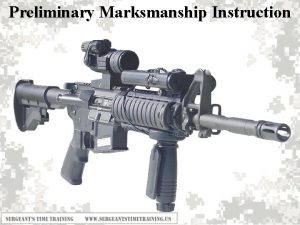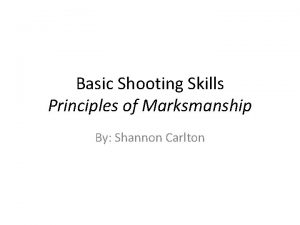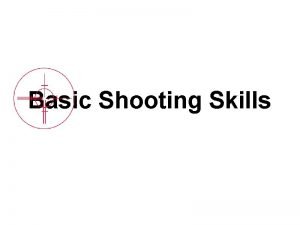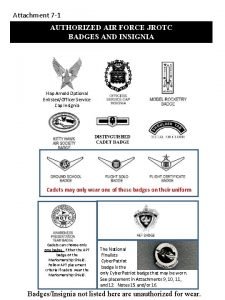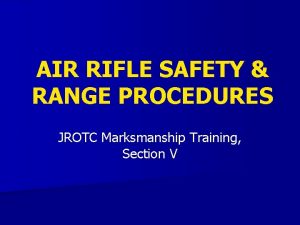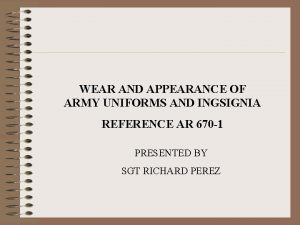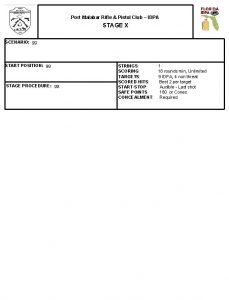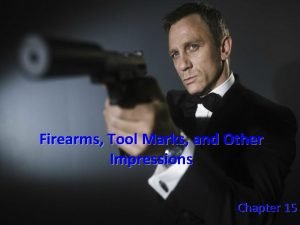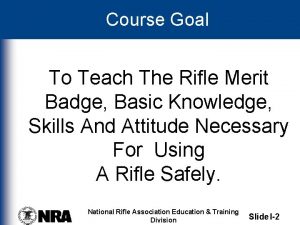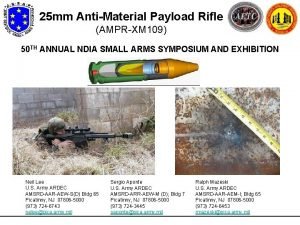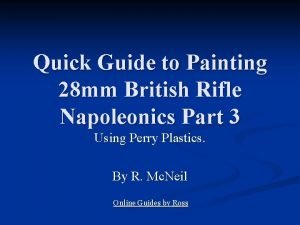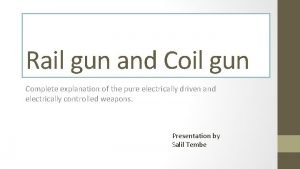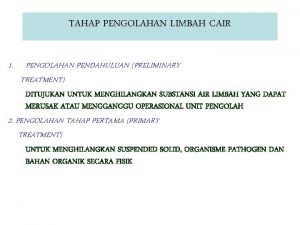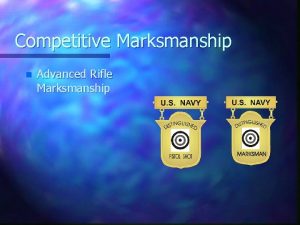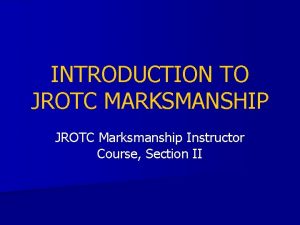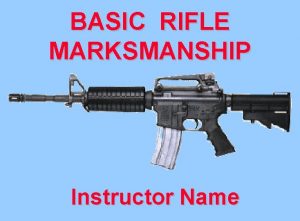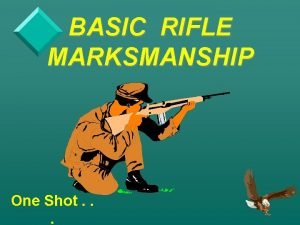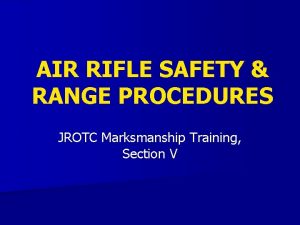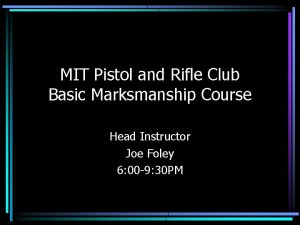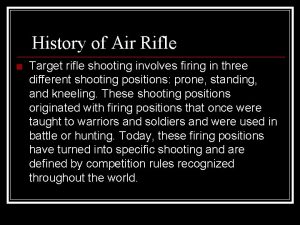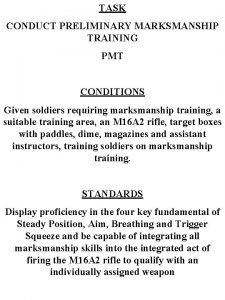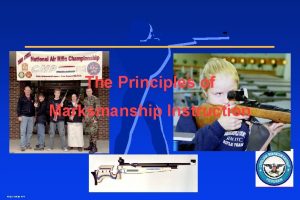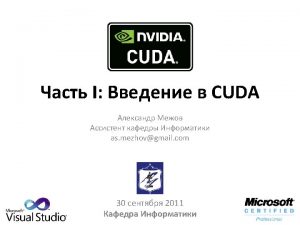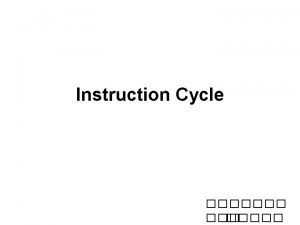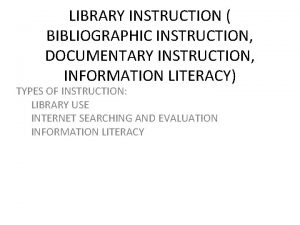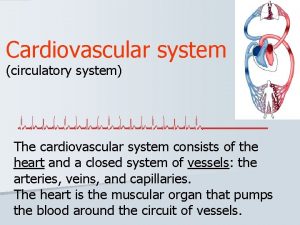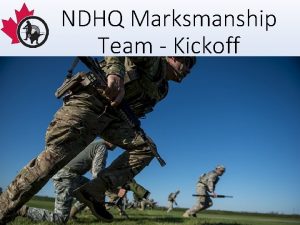Preliminary Marksmanship Instruction M 4 RIFLE SYSTEM Consists


























- Slides: 26

Preliminary Marksmanship Instruction

M 4 RIFLE SYSTEM Consists of a Rifle, a Magazine, and a Sling. It Is a Lightweight, Gas Operated, Air-Cooled, Magazine Fed Shoulder Fired Weapon That Can Be Fired Either in Semi-Automatic or Three Round Bursts.

M 4 SPECIFICATIONS CALIBER: 5. 56 mm MUZZLE VELOCITY: 2, 970 fps WEIGHT: w/MAG – 7. 5 lbs w/o MAG – 6. 49 lbs MAX EFF RANGE: 500 M (Point) / 600 M (Area) MAX RANGE: 3600 M LENGTH: 29. 75 inches (BS closed)/33. 0 inches (BS open) BARREL RIFLING 1: 7 Ratio

PROCEDURE FOR CLEARING THE M 4 RIFLE • Point the muzzle in a designated SAFE DIRECTION. Attempt to place selector lever on SAFE. If weapon is not cocked, lever cannot be placed on SAFE. • Remove the magazine by depressing the magazine catch button and pulling the magazine down. • To lock bolt open, pull charging handle rearward. Press bottom of bolt catch and allow bolt to move forward until it engages bolt catch. Return charging handle to full forward position. If you have not done so before, place the selector lever on SAFE. • Visually (not physically) inspect the receiver and chamber to ensure these areas contain no ammo. • With the selector lever pointing toward SAFE, allow the bolt to go forward by pressing the upper portion of the bolt catch. • Place the selector lever on SEMI and squeeze the trigger. • Pull the charging handle fully rearward and release it, allowing the bolt to return to the full forward position. • Place the selector lever on SAFE. • Close the ejection port cover.

DISASSEMBLY 1. 2. 3. 4. 5. 6. Remove Sling Remove Handguards Remove Upper and Lower Receiver Remove Bolt Carrier group and Bolt Remove Charging Handle Disassemble Bolt Carrier group a. Firing Pin Retaining Pin b. Firing Pin c. Bolt Cam Pin d. Bolt e. Extractor and Extractor Pin 7. Remove Buffer & Buffer Spring

INSPECT WHILE YOU ARE CLEANING YOUR M 4 RIFLE YOU SHOULD BE INSPECTING ALL PARTS FOR CRACKS OR FRACTURES, CHIPS, BENT OR MISSING PARTS.

LUBRICATE 1. LIGHTLY LUBE - Barely Visible to the Eye. This is to be performed for weapons cleaning or prior to operation of the weapon system. 2. HEAVY LUBE - Heavy Enough So That It Can Be Spread With Your Finger. This is to be performed to the weapon system prior to turning in the weapon to the arms room.

FUNCTIONS CHECK FOR M 4 RIFLE 1. 2. 3. 4. 5. 6. 7. Weapon will start in the SEMI position. Pull charging handle to the rear and release. Place selector switch on SAFE. Pull the trigger; the hammer should not fall. Place the selector on SEMI. Pull the trigger and hold to the rear; the hammer should fall. While holding the trigger back, pull the charging handle to the rear and release it. 8. Release the trigger and pull it again; the hammer should fall. 9. Place the selector on BURST. 10. Pull the charging handle to the rear and release. 11. Pull the trigger and hold to the rear; the hammer should fall. 12. Pull the charging handle to the rear THREE times and release. 13. Release the trigger and pull it again; the hammer should fall. WHEN FINISHED WITH FUNCTIONS CHECK PLACE WEAPON ON SAFE

Load an M 4 rifle. Notice: Always place the rifle on SAFE when loading and unloading. 1. 2. 3. 4. Point the muzzle of the rifle in a safe direction. Cock the rifle and lock the bolt to the rear. Return the charging handle to the forward position. Insert a loaded magazine into the magazine housing and push upward until the magazine catch engages and holds the magazine in place. 5. Gently tap the base (bottom) of the magazine with the heel of the hand to ensure the magazine is locked in place (seated). 6. Depress upper portion of bolt catch allowing the bolt to go forward. 7. Strike (tap) the forward assist assembly to ensure that the bolt is fully forward and locked. Notice: If rifle is loaded with bolt closed, a round is chambered by pulling the charging handle to the rear and releasing. DO NOT ride the charging handle forward. If the charging handle is eased forward from the open position, the bolt may fail to lock.

Unload an M 4 rifle. Notice: Always place the rifle on SAFE when loading and unloading. 1. Point the muzzle of the rifle in a safe direction. 2. Place the selector lever on SAFE. (If weapon is not cocked, the lever cannot be placed on SAFE. ) 3. Press in on the magazine catch button and pull the magazine down and out of the weapon. 4. Pull the charging handle to the rear, press the bottom of the bolt catch, and allow the bolt to ease forward until it engages the bolt catch. (Place weapon on SAFE if not done so already. ) Return the charging handle to the forward position. 5. Look into the chamber and receiver to ensure these areas contain no ammunition. 6. With selector pointing to SAFE, allow bolt to go forward by pressing upper position of bolt catch.

AMMUNITION 1. 2. 3. 4. 5. 6. M 193 – Ball M 196 – Tracer M 200 – Blank (Violet tip and 7 petal rose crimp) M 855 – Ball (Green Tip) M 856 – Tracer (Red Tip) M 862 – Short Range Training Ammunition (Plastic with a Blue Tip)

IMMEDIATE ACTION “ SPORTS ”

IMMEDIATE ACTION S -- Slap up on the Magazine P -- Pull the Charging Handle O -- Observe the Chamber R -- Release the Charging Handle T -- Tap the Forward Assist S -- Squeeze the Trigger

MARKSMANSHIP FUNDAMENTALS • • Steady Position Sight Picture/Sight Alignment Breathing Trigger Squeeze

MARKSMANSHIP FUNDAMENTALS The soldier must understand the four key fundamentals before he approaches the firing line. He must be able to establish a steady position that allows observation of the target. He must aim (sight picture/sight alignment) the rifle at the target by aligning the sight system, and he must fire the rifle without disturbing this alignment by improper breathing or during trigger squeeze. The skills needed to accomplish these are known as rifle marksmanship fundamentals. These simple procedures aid the firer in achieving target hits under many conditions when expanded with additional techniques and information. Applying these four fundamentals rapidly and consistently is called the integrated act of firing. Steady Position. When the soldier approaches the firing line, he should assume a comfortable, steady firing position in order to hit targets consistently. The time and supervision each soldier has on the firing line are limited. Therefore, he must learn how to establish a steady position during dry-fire training. The firer is the best judge as to the quality of his position. If he can hold the front sight post steady through the fall of the hammer, he has a good position. The steady position elements are as follows:

Nonfiring hand grip. The rifle handguard rests on the heel of the hand in the V formed by the thumb and fingers. The grip of the nonfiring hand is light, and slight rearward pressure is exerted. Rifle butt position. The butt of the stock is placed in the pocket of the firing shoulder. This reduces the effect of recoil and helps ensure a steady position. Firing hand grip. The firing hand grasps the pistol grip so that it fits the V formed by the thumb and forefinger. The forefinger is placed on the trigger so that the lay of the rifle is not disturbed when the trigger is squeezed. A slight rearward pressure is exerted by the remaining three fingers to ensure that the butt of the stock remains in the pocket of the shoulder, thus minimizing the effect of recoil. Firing elbow placement. The location of the firing elbow is important in providing balance. The exact location, however, depends on the firing/fighting position used - for example, kneeling, prone, or standing. Placement should allow shoulders to remain level. Nonfiring elbow. The nonfiring elbow is positioned firmly under the rifle to allow for a comfortable and stable position. When the soldier engages a wide sector of fire, moving targets, and targets at various elevations, his nonfiring elbow should remain free from support. Stock weld. The stock weld is taught as an integral part of various positions. Two key factors emphasized are that the stock weld should provide for a natural line of sight through the center of the rear sight aperture to the front sight post and to the target. Through dry-fire training, the soldier is encouraged to practice this position until he assumes the same stock weld each time he assumes a given position. This provides consistency in aiming, which is the purpose of obtaining a correct stock weld.

Support. If artificial support (sandbags, logs, stumps) is available, it should be used to steady the position and to support the rifle. If it is not available, then the bones, not the muscles, in the firer's upper body must support the rifle. Aiming. Focusing on the front sight post is a vital skill the firer must acquire during practice. Having mastered the task of holding the rifle steady, the soldier must align the rifle with the target in exactly the same way for each firing. The firer is the final judge as to where his eye is focused. The instructor/trainer emphasizes this point by having the firer focus on the target and then focus back on the front sight post. He checks the position of the firing eye to ensure it is in line with the rear sight aperture. He uses the M 4 sighting device to see what the firer sees through the sights. Rifle sight alignment. Alignment of the rifle with the target is critical. It involves placing the tip of the front sight post in the center of the rear sight aperture. (Figure 3 -4. ) Any alignment error between the front and rear sights repeats itself for every 1/2 meter the bullet travels. For example, at the 25 -meter line, any error in rifle alignment is multiplied 50 times. If the rifle is misaligned by 1/10 inch, it causes a target at 300 meters to be missed by 5 feet.

Focus of the eye. A proper firing position places the eye directly on line with the center of the rear sight. When the eye is focused on the front sight post, the natural ability of the eye to center objects in a circle and to seek the point of greatest light (center of the aperture) aid in providing correct sight alignment. For the average soldier firing at combat-type targets, the natural ability of the eye can accurately align the sights. Therefore, the firer can place the tip of the front sight post on the aiming point, but the eye must be focused on the tip of the front sight post. This causes the target to appear blurry, while the front sight post is seen clearly. Two reasons for focusing on the tip of the front sight post are: Sight picture. Once the soldier can correctly align his sights, he can obtain a sight picture. A correct sight picture has the target, front sight post, and rear sight aligned. The sight picture includes two basic elements: sight alignment and placement of the aiming point. Placement of the aiming point varies, depending on the engagement range. For example, Figure 3 -5 shows a silhouette at 250 meters--the aiming point is the center of mass, and the sights are in perfect alignment; this is a correct sight picture.

Breath Control. As the firer's skills improve and as timed or multiple targets are presented, he must learn to hold his breath at any part of the breathing cycle. Two types of breath control techniques are practiced during dry fire. • The first is the technique used during zeroing (and when time is available to fire a shot) (Figure 3 -7 A. There is a moment of natural respiratory pause while breathing when most of the air has been exhaled from the lungs and before inhaling. Breathing should stop after most of the air has been exhaled during the normal breathing cycle. The shot must be fired before the soldier feels any discomfort. • The second breath control technique is employed during rapid fire (short-exposure targets) (Figure 37 B). Using this technique, the soldier holds his breath when he is about to squeeze the trigger.

Trigger Squeeze. A novice firer can learn to place the rifle in a steady position and to correctly aim at the target if he follows basic principles. If the trigger is not properly squeezed, the rifle is misaligned with the target at the moment of firing. Rifle movement. Trigger squeeze is important for two reasons: ·First, any sudden movement of the finger on the trigger can disturb the lay of the rifle and cause the shot to miss the target. ·Second, the precise instant of firing should be a surprise to the soldier. The soldier's natural reflex to compensate for the noise and slight punch in the shoulder can cause him to miss the target if he knows the exact instant the rifle will fire. The soldier usually tenses his shoulders when expecting the rifle to fire, but it is difficult to detect since he does not realize he is flinching. When the hammer drops on a dummy round and does not fire, the soldier's natural reflexes demonstrate that he is improperly squeezing the trigger. Note: Dime and Washer Drills will vastly improve your trigger squeeze.

FIRING POSITIONS Basic Firing Positions. Two firing positions are used during initial fundamental training: the individual supported fighting position and prone unsupported position. Both offer a stable platform for firing the rifle. Supported fighting position. This position provides the most stable platform for engaging targets (Figure 3 -8). Upon entering the position, the soldier adds or removes dirt, sandbags, or other supports to adjust for his height. He then faces the target, executes a half-face to his firing side, and leans forward until his chest is against the firing-hand corner of the position. He places the rifle handguard in a V formed by the thumb and fingers of his nonfiring hand, and rests the nonfiring hand on the material (sandbags or berm) to the front of the position. The soldier places the stock butt in the pocket of his firing shoulder and rests his firing elbow on the ground outside the position. (When prepared positions are not available, the prone supported position can be substituted. )

Prone unsupported position. This firing position (Figure 3 -9) offers another stable firing platform for engaging targets. To assume this position, the soldier faces his target, spreads his feet a comfortable distance apart, and drops to his knees. Using the butt of the rifle as a pivot, the firer rolls onto his nonfiring side, placing the nonfiring elbow close to the side of the magazine. He places the rifle butt in the pocket formed by the firing shoulder, grasps the pistol grip with his firing hand, and lowers the firing elbow to the ground. The rifle rests in the V formed by the thumb and fingers of the nonfiring hand. The soldier adjusts the position of his firing elbow until his shoulders are about level, and pulls back firmly on the rifle with both hands. To complete the position, he obtains a stock weld and relaxes, keeping his heels close to the ground.

PRACTICAL EXERCISES 1. MAINTAIN AND PERFORM AN FUNCTION CHECK ON AN M 4 RIFLE 2. CORRECT MALFUNCTIONS OF AN M 4 RIFLE

DRY-FIRE EXERCISES 1. DIME/WASHER 2. DRY-FIRE TARGET

ONE SHOT ONE KILL

ANY QUESTIONS?
 Preliminary rifle instruction
Preliminary rifle instruction 5 principles of marksmanship
5 principles of marksmanship Importance of marksmanship
Importance of marksmanship Jrotc badges
Jrotc badges Jrotc marksmanship test
Jrotc marksmanship test Usmc jrotc vacancies
Usmc jrotc vacancies Army skill badges placement on ocp
Army skill badges placement on ocp Jrotc marksmanship instructor course online
Jrotc marksmanship instructor course online Individualized instruction vs differentiated instruction
Individualized instruction vs differentiated instruction Difference between direct and indirect instruction
Difference between direct and indirect instruction Port malabar shooting range
Port malabar shooting range Rimfire vs centerfire rifle
Rimfire vs centerfire rifle Parts of a bolt action rifle
Parts of a bolt action rifle Prerenal renal ayrımı
Prerenal renal ayrımı Rifle kriterleri
Rifle kriterleri Fena formula
Fena formula Antimaterial rifle
Antimaterial rifle Springfield model 1861 rifle facts
Springfield model 1861 rifle facts Rifle painting preparation
Rifle painting preparation Criteri rifle ira
Criteri rifle ira Nta rene
Nta rene Injuria renal aguda akin
Injuria renal aguda akin Railgun vs coilgun
Railgun vs coilgun Rifle scope diagram
Rifle scope diagram Erland herfindahl
Erland herfindahl Preliminary budget
Preliminary budget Preliminary treatment adalah
Preliminary treatment adalah
